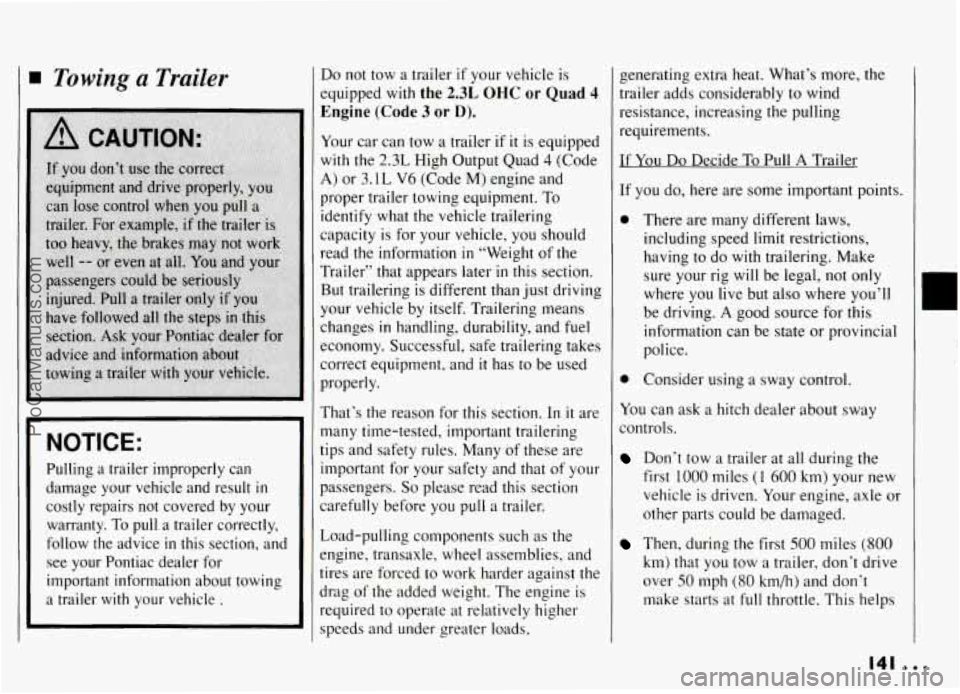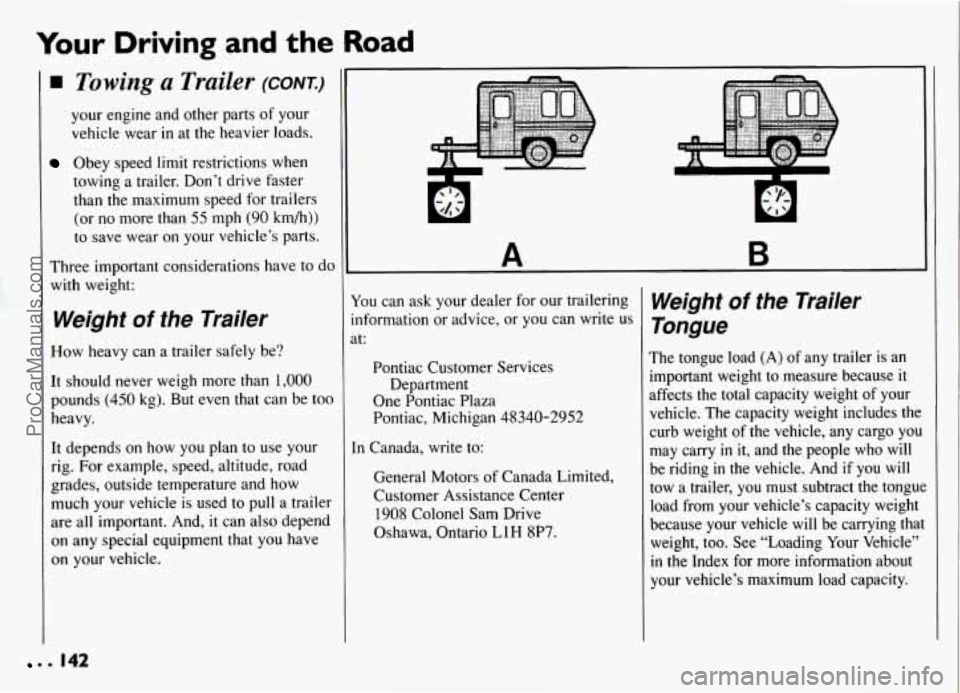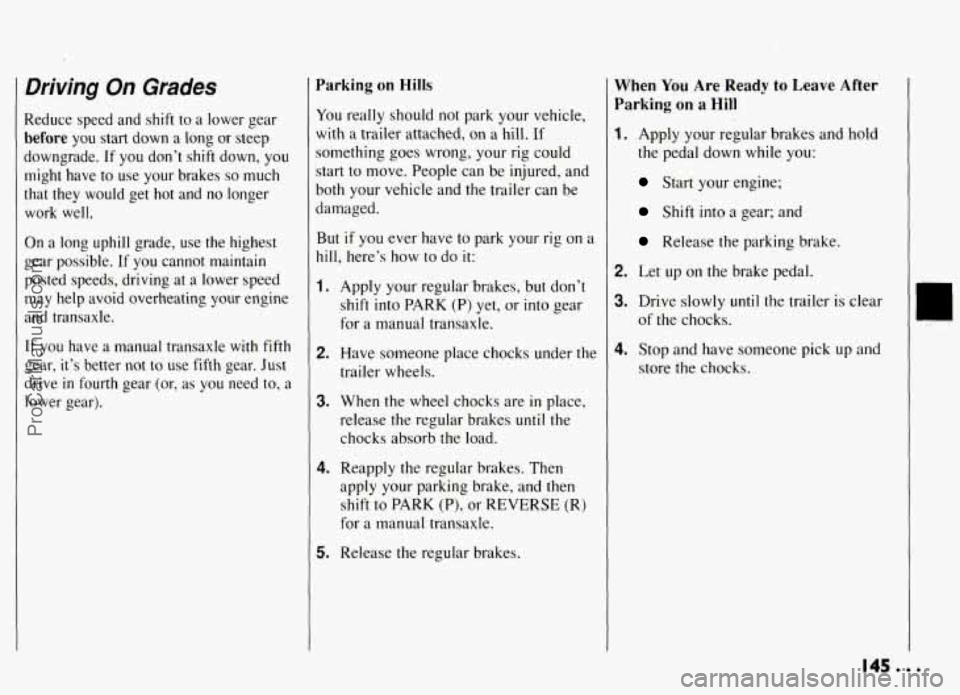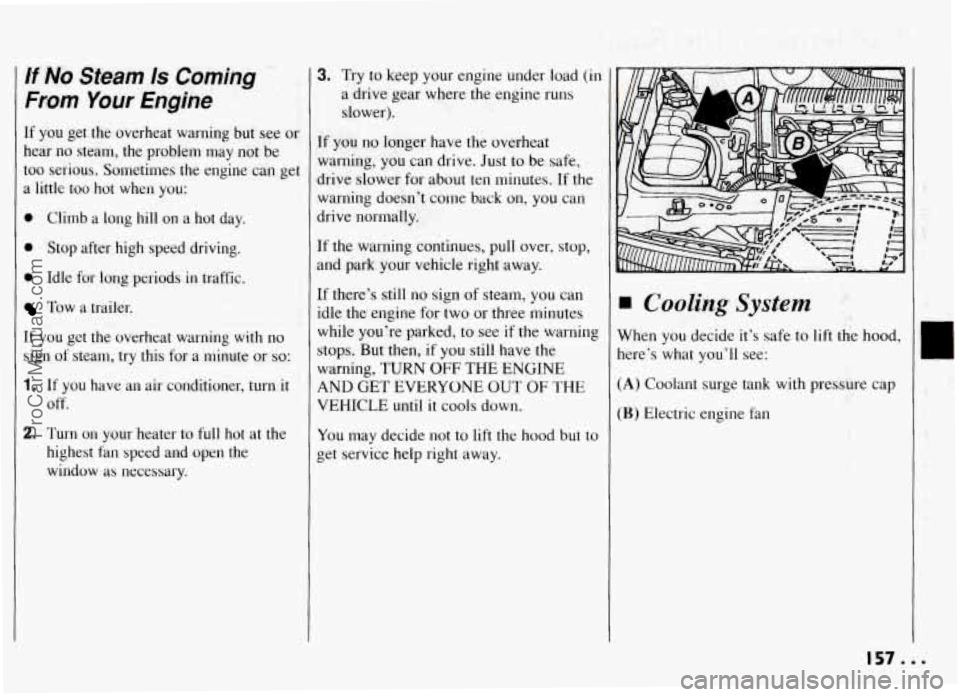Page 142 of 274

Towing a Trailer
NOTICE:
Pulling a trailer improperly can
damage your vehicle and result
in
costly repairs not covered by your
warranty. To pull
a trailer correctly,
follow the advice
in this section, and
see your Pontiac dealer for important information about towing
a trailer
with your vehicle .
Do not tow a trailer if your vehicle is
equipped with the 2.3L OHC or Quad 4
Engine (Code 3 or D).
Your car can tow a trailer if it is equipped
with the
2.3L High Output Quad 4 (Code
A) or 3.1 L V6 (Code M) engine and
proper trailer towing equipment. To
identify what the vehicle trailering
capacity is for your vehicle, you should
read the information
in ‘‘Weight of the
Trailer” that appears later
in this section.
But trailering is different than just driving
your vehicle by itself. Trailering means
changes
in handling, durability, and fuel
economy. Successful, safe trailering takes
correct equipment, and
it has to be used
properly.
That’s the reason for this section. In it are
many time-tested, important trailering
tips and safety rules. Many of these are
important for your safety and that of your
passengers.
So please read this section
carefully before you puli a trailer.
Load-pulling components such as the
mgine, transaxle, wheel assemblies, and
tires are forced
to work harder against the
jrag of the added weight. The engine is
required to operate at relatively higher
speeds and under greater loads,
generating extra heat. What’s more, the
trailer adds considerably to wind
resistance, increasing the pulling
requirements.
If You Do Decide To Pull A Trailer
If you do, here are some important points.
0 There are many different laws,
including speed limit restrictions,
having to do with trailering. Make
sure your rig will be legal, not only
where you live but also where you’ll
be driving.
A good source for this
information can be state or provincial
police.
0 Consider using a sway control.
You can ask a hitch dealer about sway
controls.
Don’t tow a trailer at all during the
first 1000 miles (1 600 km) your new
vehicle is driven. Your engine, axle or
other parts could be damaged.
Then, during the first 500 miles (800
km) that you tow a trailer, don’t drive
over
50 mph (80 km/h) and don’t
make starts
at full throttle. This helps
141
ProCarManuals.com
Page 143 of 274

Your Driving and the Road
Towing a Trailer (CONK)
your engine and other parts of your
vehicle wear
in at the heavier loads.
Obey speed limit restrictions when
towing a trailer. Don’t drive faster
than the maximum speed for trailers
(or no more than
55 mph (90 km/h))
to save wear on your vehicle’s parts.
Three important considerations have to do
with weight:
Weight of the Trailer
How heavy can a trailer safely be?
It should never weigh more than 1,000
pounds (450 kg). But even that can be too
heavy.
It depends on how you plan to use your
rig. For example, speed, altitude, road
grades, outside temperature and how
much your vehicle is used to pull a trailer
are all important. And,
it can also depend
on any special equipment that you have
on your vehicle.
A B
fou can ask your dealer for our trailering
nformation or advice, or you can write
us
It:
Pontiac Customer Services
Department
One Pontiac Plaza
Pontiac, Michigan 48340-2952
[n Canada, write to:
General Motors of Canada Limited,
Customer Assistance Center
1908 Colonel Sam Drive
Oshawa, Ontario L1H 8P7.
Weight of the Trailer
Tongue
The tongue load (A) of any trailer is an
important weight to measure because
it
affects the total capacity weight of your
vehicle. The capacity weight includes the
curb weight of the vehicle, any cargo you
may carry
in it, and the people who will
be riding in the vehicle. And if you will
tow a trailer, you must subtract the tongu
load from your vehicle’s capacity weight
because your vehicle
will be carrying tha
weight, too. See “Loading Your Vehicle”
in the Index for more information about
your vehicle’s maximum load capacity.
. . 142
ProCarManuals.com
Page 146 of 274

1 Driving On Grades
Reduce speed and shift to a lower gear
before you start down a long or steep
downgrade. If you don’t shift down,
you
might have to use your brakes so much
that they would get hot and no longer
work well.
On a long uphill grade, use the highest
gear possible. If you cannot maintain
posted speeds, driving at a lower speed
may help avoid overheating your engine
and transaxle.
If you have a manual transaxle with fifth
gear, it’s better not to use fifth gear. Just
drive
in fourth gear (or, as you need to, a
lower gear).
Parking on Hills
You really should not park your vehicle,
with a trailer attached, on
a hill. If
something goes wrong, your rig could
start to move. People can be injured, and
both your vehicle and the trailer can be
damaged.
But if you ever have to park your rig on a
hill, here’s how to do it:
1. Apply your regular‘brakes, but don’t
shift into PARK (P) yet, or into gear
for a manual transaxle.
2. Have someone place chocks under the
trailer wheels.
3. When the wheel chocks are in place,
release the regular brakes
until the
chocks absorb the load.
4. Reapply the regular brakes. Then
apply your parking brake, and then
shift to PARK
(P), or REVERSE (R)
for a manual transaxle.
5. Release the regular brakes.
When You Are Ready to Leave After
Parking
on a Hill
1. Apply your regular brakes and hold
the pedal down while you:
Start your engine;
Shift into a gear; and
Release the parking brake.
2. Let up on the brake pedal.
3. Drive slowly until the trailer is clear
of the chocks.
4. Stop and have someone pick up and
store the chocks.
145...
ProCarManuals.com
Page 147 of 274
Your Driving and the Road
Maintenance When Trailer
Towing
Your vehicle will need service more often
when you’re pulling a trailer. See the
Maintenance Schedule for more on this.
Things that are especially important in
trailer operation are automatic transaxle
fluid (don’t overfill), engine oil, belts,
cooling system, and brake adjustment.
Each of these is co%ered in this manual,
and the Index will help you find them
quickly. If you’re trailering, it’s a good
idea to review these sections before
you
start your .trip.
Check periodically to see that all hitch
b e 146
ProCarManuals.com
Page 148 of 274
Here you’ll find what to do about
some problems that can occur on the
road .
Problems on the
Part 5
Road
Hazard Warning Flashers ............................................
Jumpstarting .....................................................
TowingYourPontiac ...............................................
Engine Overheating ................................................
If Steam is Coming From Your Engine .................................
If a Tire Goes Flat .................................................
ChangingaFlatTire ................................................
Compactspare ....................................................
If You’re Stuck: In Sand, Mud, Ice or Snow .............................
148
148
152
156
156
161
162
167
167
147 ...
ProCarManuals.com
Page 151 of 274
Problems on the Road
To Jump Start Your
Pontiac: (CONK)
5. Check that the jumper cables don’t
have loose or missing insulation.
If
they do, you could get a shock. The
vehicle? could be damaged, too.
Before you connect the cables, here
are some basic things
you should
know. Positive
(+) will go to positive
(+) and negative (-) will go to negative
(-) or a metal engine part.
Don’t connect (+) to (-) or you’ll get a
short that would damage the battery
and maybe other parts, too.
6. Connect the red positive (+) cable to
the positive (+) terminal of the vehicle
with the dead battery.
Use a remote positive (+) terminal if
the vehicle has one.
ProCarManuals.com
Page 157 of 274
Problems on the Road
Towing from the
Rear-Vehicle
Hook-Up
(CONT.)
Attach a separate safety chain to each side
of the axle inboard of the spring.
Engine Overheating
You will find a coolant temperature gage
or the warning light about a hot engine on
your Pontiac’s instrument panel. See
“Coolant Temperature Gage” and
“Coolant Temperature Warning Light”; in
the Index. You will also find
a low
coolant warning light
on your Pontiac’s
instrument panel.
If Steam Is Coming From
Your Engine NOTICE:
If your engine catches fire because
you keep driving with no coolant,
your vehicle can be badly damaged.
The costly repairs would not be
covered by your warranty.
ProCarManuals.com
Page 158 of 274

If No Steam 1s Coming
From Your Engine
If you get the overheat warning but see or
hear no steam, the problem may not be
too serious. Sometimes the engine can get
a little too hot when you:
0 Climb a long hill on a hot day.
0 Stop after high speed driving.
0 Idle for long periods in traffic.
Tow a trailer.
[f you get the overheat warning with no
sign of steam, try this for a minute or so:
1. If you have an air conditioner, turn it
off.
2. Turn on your heater to full hot at the
highest fan speed and open the
window as necessary.
3. Try to keep your engine under load (in
a drive gear where the engine runs
slower).
If you no longer have the overheat
warning,
you can drive. Just to be safe,
drive slower for about ten minutes.
If the
warning doesn't come back on, you can
drive normally.
If the warning continues, pull over, stop,
and park your vehicle right away.
[f there's still no sign of steam, you can
idle the engine for two or three minutes
while you're parked, to see
if the warning
stops. But then, if you still have the
warning, TURN
OFF THE ENGINE
4ND GET EVERYONE OUT
OF THE
VEHICLE until it cools down.
You may decide not to lift the hood but to
get service help right away.
Cooling System
When you decide it's safe to lift the hood,
here's what you'll see:
(A) Coolant surge tank with pressure cap
(B) Electric engine fan ii" , I .. i I. i. 4:. .;I'
.r': 5.
157...
ProCarManuals.com